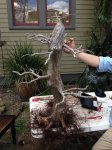markyscott
Imperial Masterpiece
I've posted pictures of this elm on a number of different threads. But it's a big boy - thought it deserved a thread of its own.
I believe that this is a Winged Elm - Ulmus alata, although it may be a Cedar Elm - Ulmus crassifolia as well. It was dug and chopped by longtime Houston Bonsai Society member George Pepitone in the early 90s. George planted it in his yard where it grew until his death - nearly a decade. A friend purchased it from the family, dug it out of the garden and grew it in a training pot for many years until I purchased it in 2013. By then, the massive chop was completely barked over, but the branches had grown wild. The tree is big - it's 44" tall and the trunks is about 7" across 4" above the soil line.
It was healthy, but not trained. Thick branches had grown, but they were straight and had no taper. I decided to start over on the branch structure. So February, 2014 was a major cutback and repot. Sorry I can't find the 'before' pictures, but here are some 'during'.


During repot, I attempted to graft some roots into place on bare spots along the nebari.

I believe that this is a Winged Elm - Ulmus alata, although it may be a Cedar Elm - Ulmus crassifolia as well. It was dug and chopped by longtime Houston Bonsai Society member George Pepitone in the early 90s. George planted it in his yard where it grew until his death - nearly a decade. A friend purchased it from the family, dug it out of the garden and grew it in a training pot for many years until I purchased it in 2013. By then, the massive chop was completely barked over, but the branches had grown wild. The tree is big - it's 44" tall and the trunks is about 7" across 4" above the soil line.
It was healthy, but not trained. Thick branches had grown, but they were straight and had no taper. I decided to start over on the branch structure. So February, 2014 was a major cutback and repot. Sorry I can't find the 'before' pictures, but here are some 'during'.


During repot, I attempted to graft some roots into place on bare spots along the nebari.


























